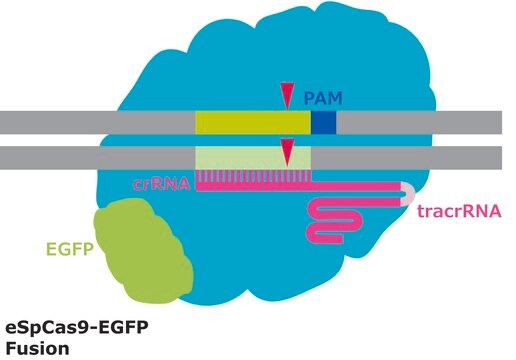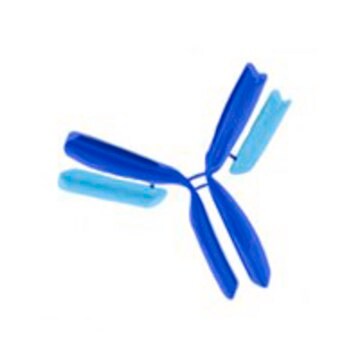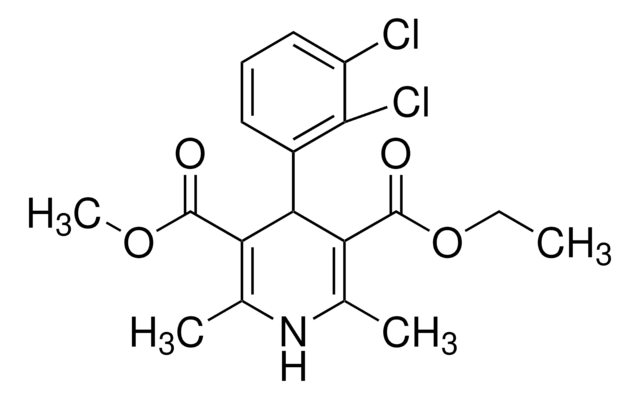P6487
Anti-Purinergic Receptor P2Y1 antibody produced in rabbit
affinity isolated antibody, lyophilized powder
Autenticatiper visualizzare i prezzi riservati alla tua organizzazione & contrattuali
About This Item
Codice UNSPSC:
12352203
NACRES:
NA.41
Prodotti consigliati
Origine biologica
rabbit
Livello qualitativo
Coniugato
unconjugated
Forma dell’anticorpo
affinity isolated antibody
Tipo di anticorpo
primary antibodies
Clone
polyclonal
Stato
lyophilized powder
Reattività contro le specie
human, rat
tecniche
immunohistochemistry: suitable
western blot: suitable
N° accesso UniProt
Temperatura di conservazione
−20°C
modifica post-traduzionali bersaglio
unmodified
Informazioni sul gene
human ... P2RY1(5028)
rat ... P2ry1(25265)
Categorie correlate
Descrizione generale
Purinergic Receptor P2Y1 is a member of G protein-coupled receptors. The P2Y1 gene is mapped to human chromosome 3q25.2. It is present in the heart, blood vessels, prostate, testis, ovary, and neural tissue.
Immunogeno
synthetic peptide corresponding to residues 242-258 of rat or human P2Y1.
Applicazioni
Anti-Purinergic Receptor P2Y1 antibody produced in rabbit has been used in western blotting1:200 and immunohistochemistry at a dilution of 1:50.
Azioni biochim/fisiol
Purinergic Receptor P2Y1 acts as a receptor for extracellular ATP and ADP. It is essential for ADP-induced platelet activation, aggregation, and thrombosis. P2Y1 also participates in endothelial cell-based nucleotide-induced relaxation and in calcium mobilization. It serves as a potential target for the generation of new antiplatelet compounds and anti-inflammatory strategies.
Stato fisico
Lyophilized from phosphate buffered saline, pH 7.4, 1% bovine serum albumin and 0.05% sodium azide.
Esclusione di responsabilità
Unless otherwise stated in our catalog or other company documentation accompanying the product(s), our products are intended for research use only and are not to be used for any other purpose, which includes but is not limited to, unauthorized commercial uses, in vitro diagnostic uses, ex vivo or in vivo therapeutic uses or any type of consumption or application to humans or animals.
Non trovi il prodotto giusto?
Prova il nostro Motore di ricerca dei prodotti.
Scegli una delle versioni più recenti:
Possiedi già questo prodotto?
I documenti relativi ai prodotti acquistati recentemente sono disponibili nell’Archivio dei documenti.
Autocrine activation of P2Y1 receptors couples Ca (2+) influx to Ca (2+) release in human pancreatic beta cells.
Khan S, Yan-Do R, Duong E, et al.
Diabetologia, 57(12), 2535-2545 (2014)
[Fatigue fracture of bone (author's transl)].
J Sebek et al.
Acta chirurgiae orthopaedicae et traumatologiae Cechoslovaca, 43(4), 364-366 (1976-08-01)
Shara Khan et al.
Diabetologia, 57(12), 2535-2545 (2014-09-12)
There is evidence that ATP acts as an autocrine signal in beta cells but the receptors and pathways involved are incompletely understood. Here we investigate the receptor subtype(s) and mechanism(s) mediating the effects of ATP on human beta cells. We
F R Seiler et al.
Developments in biological standardization, 44, 153-163 (1979-01-01)
Unspecifically induced activation of Complement (C) in solution can be caused either by denatured Ig molecules and by polymeric aggregates of same or more specifically by antigen-antibody complexes. As a quality criteria, e.g. for i.v.-IgG preparations, it is agreed by
Milka Koupenova et al.
Frontiers in pharmacology, 9, 37-37 (2018-02-15)
Platelets are small anucleated cells present only in mammals. Platelets mediate intravascular hemostatic balance, prevent interstitial bleeding, and have a major role in thrombosis. Activation of platelet purinergic receptors is instrumental in initiation of hemostasis and formation of the hemostatic
Il team dei nostri ricercatori vanta grande esperienza in tutte le aree della ricerca quali Life Science, scienza dei materiali, sintesi chimica, cromatografia, discipline analitiche, ecc..
Contatta l'Assistenza Tecnica.






